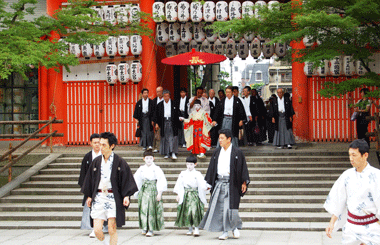Yes indeed, it’s July 1 and for Kyoto it’s the beginning of the month-long Gion Festival, dubbed one of Kyoto’s Big Three (along with Aoi and Jidai Matsuri). It’s one of Japan’s oldest and biggest affairs, and there are many websites devoted to the event. For me it’s a true People’s Festival and a wonderful display of Kyoto culture at its finest.
The following brief description comes from the Kyoto Visitors Guide (which has an excellent interview with one of the festival musicians playing ‘Gion bayashi’): ‘Last year was a historical moment for the festival exactly 48 years in history, when the Gion Festival returned back to its original form. The commonly known united-procession was separated into the Saki Matsuri and the Ato Matsuri. So this year will be the 2nd special year to witness the revived Ato Matsuri.
The Saki Matsuri’s parade is gorgeous and boisterous with many floats as usual. In contrast, the revived Ato Matsuri is held in a much quieter atmosphere as there will be no stalls, nor extra goodies, etc. For tourists who can stay a bit longer, you may have a great chance to see the contrast of both the gorgeous and fun Saki Matsuri along with the solemn and beautiful Ato Matsuri, like the yin and yang of the festival.’

On July 1 the chigo (sacred page) of the main float Naginata-hoko visits Yasaka Jinja to pray for a safe festival. (courtesy Kyoto Visitors Guide)
The festival was kicked off this morning with a visit to Yasaka Jinja, host shrine of the event, by the chigo (sacred page) to pray for safety. There then follow a whole series of rites and ceremonies throughout the following month, with the highlight being the main procession on the 17th.
The following listing comes courtesy of Wikipedia….
- July 1 through 5: Kippuiri, opening ceremony of festival, in each participating neighbourhood
- July 2: Kujitorishiki, lottery for the parade order, in the municipal assembly hall
- July 7: Shrine visit by chigo children of Ayagasaboko
- July 10: Lantern parade to welcome mikoshi portable shrines
- July 10: Mikoshi arai, cleansing of mikoshi by sacred water from the Kamo River
- July 10 through 13: Building-up of floats(Former parade)
- July 13 a.m.: Shrine visit by chigo children of Naginataboko
- July 13 p.m.: Shrine visit by chigo children of Kuse Shrine
- July 14: Yoiyoiyoiyama(Former parade)
- July 15: Yoiyoiyama(Former parade)
- July 16: Yoiyama(Former parade)
- July 16: Yoimiya shinshin hono shinji, dedicative art performances
- July 17: Parade of yamaboko floats(Former parade)
- July 17: Parade of mikoshi from Yasaka Shrine to the city
- July 18 through 20: Building-up of floats(Latter parade)
- July 21: Yoiyoiyoiyama(Latter parade)
- July 22: Yoiyoiyama(Latter parade)
- July 23: Yoiyama(Latter parade)
- July 24: Parade of yamaboko floats(Latter parade)
- July 24: Parade of hanagasa or “flower parasols”
- July 24: Parade of mikoshi from the city to Yasaka Shrine
- July 28: Mikoshi arai, cleansing of mikoshi by sacred water from the Kamo river
- July 31: Closing service at Eki Shrine

Leave a Reply